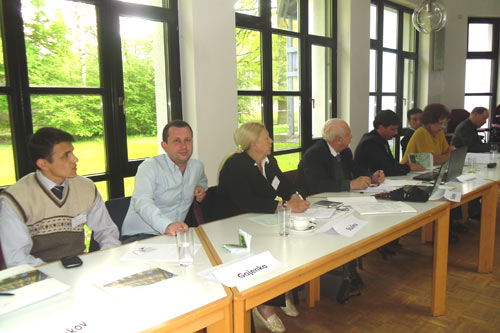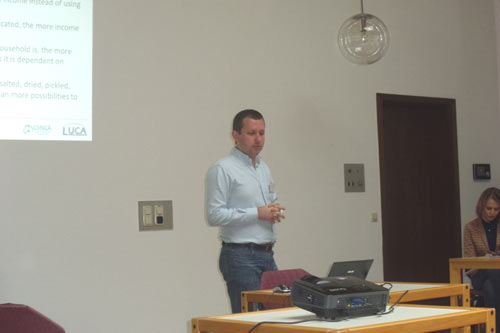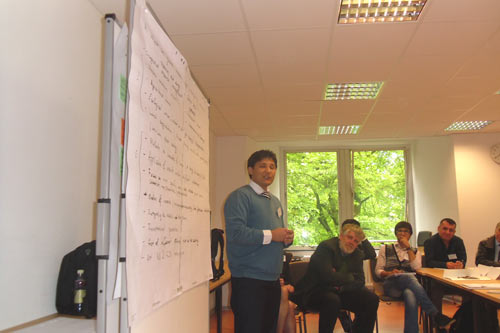SUMMER SCHOOL FOR STUDENTS FROM CENTRAL ASIA IN THE CENTER OF INTERNATIONAL DEVELOPMENT AND ENVIRONMENTAL STUDY AT THE GIESSEN UNIVERSITY IN GERMANY
The summer school for students of Central Asia was held at the University of Giessen from 6 to 11 May 2012. The summer school had two programs: LUKA - land use, ecosystem services and human well-being in Central Asia, and CLINCA - Network on Climate Change in Central Asia. The LUKA program is financed by the Volkswagen foundation and the CLINCA is financed within DAAD program. Within these two programs over 20 students from Central Asia are being trained to the masters degree and PhD, including those from Uzbekistan - 11 people, including from the SIC ICWC - 8. Education on both programs is implemented with the participation of two leaders: the first one - from Germany and the second - from the Central Asian countries.
Education on the LUKA program provides a "sandwich" system, when 40% of the time the students spend in Germany, studying methodological and theoretical approaches of German specialists, and 60% of the time they spend in the field, collecting material and conducting field studies.
The CLINCA program is somewhat different. Here, studying takes place mainly in Germany, with some field visiting.
This session is third in the current training period, which will be finished at the end of 2012. Program managers at the beginning of the session (Prof. Schmidt, Economic Research area, and Prof. Frede, Land reclamation and ecology area) briefly summarized the results of training programs and gave the word to students for open discussion about implementation and further development of educational researches. The main outcome of the discussion - is that participation of German professors provides a high level of motivation of students in possession of new scientific methods, including methods of laboratory and field studies, as well as the software use. The combination of European approaches and the Central Asian practice, coupled with deep understanding of the real situation in the region by students and the Central Asian managers can significantly improve the educational and scientific activities and to achieve the desired result.

All speakers noted a good group atmosphere and quite a lot of students' enthusiasm to finish their works in the required time. At the same time, suggestions were made to the effect that the collaborative work of two leaders and the student should begin prior to the appointment of the research topic, so that firstly the information, methods, theoretical and analytical basis for future work were agreed.
Given the certain specificity of students involved in the German environment, it is reasonable for students who are studying for the Master's degree, to continue studying for the PhD. Many speakers stressed the need for more practical purposes of topics from the beginning of defining research topics.
The whole day was devoted to reports of young scientists. Boris Gozhenko, student from Uzbekistan, in his report “Land use and food security” presented how to meet the growing population demands of Central Asian countries in food by increasing the food balance, the dynamic growth of food by increasing productivity of land and water, etc. T. Tchibaeva, student from Kyrgyzstan, in her report, presented results of study of last earthquake in the Nura area of the Pamir-Alai region; she noted that the earthquake was located near the construction site of Rogunskaya HPS. Aslanov I. studies the salt-and-dust-transfer in Uzbek part of Priaralie. He demonstrated results of analysis of salt and dust transfer sources on the Aral Sea bed. M. Dushanakunov from Kyrgyzstan presented very interesting report: “Water resources of mountain areas of Central Asia - contribution to the water balance of the fertile zone”. He collected a large observation materials, which confirmed the views expressed earlier by other researchers, including Glazyrin G., Oberhansley H., that there is no catastrophic melting of glaciers and the decrease of their volumes everywhere. Some years the glaciers increase their volumes, and other years - reduce it. This phenomenon is known in hydrology as the concept of “glaciers' breathing”.

G. Umurzakov, specialist of SIC ICWC, presented very interesting report: “Calculation of phreatic evaporation in irrigated lands, using isotopes”. Sh. Kenjebayev presented the report: “Ecohydrology in a changing environment”, which is close to previous one regarding the content. Both reports are devoted almost to the same question - the interaction of groundwater, surface water and underground water. The data obtained by Sh. Kenjebayev on the basis of theoretical studies carried out by using domestic methods and field observations in the Fergana Valley, were compared with results of ongoing assessment of the same parameters on the basis of isotope methods. It is interestingly that both authors have received a quite good match of indicators, and also that application of new methodological approaches of German scientists allows confirming the correctness of theoretical approaches, taken 50 and 30 years ago. Several reports were devoted to the research results obtained by remote sensing methods in Kazakhstan, as well as a number of economic reports based on materials of Uzbekistan, Tajikistan and Kazakhstan were presented.

Mr. Nolenburk, representative of the donor organization “Volkswagen”, participated in discussing the results of learning and research. He expressed great satisfaction with results of the work and assured participants that the decision of the Board of “Volkswagen” concerning the continuation of the project will be obviously positive. At the same time, he welcomed our proposal on financing the works on monitoring the Aral Sea bed and the Amudarya river delta, which were previously conducted by the German Agency on Scientific and Technological Cooperation GIZ, and he suggested submitting proposals to a new tender, which will be announced in November.
Summer school participants became familiar with protection of environment in the biosphere reserve “Ron”, founded in 1991 as one of the 12 reservations in Germany. The territory of 180 hectares was divided on several zones, where the work on conservation and monitoring of environmental sustainability in the region is being carried out very carefully. The biosphere reserve “Ron” is located at 250-950 m above sea level and covers an area of 185 thousand hectares in the Bavaria, Thuringia and Giessen. Here 162 thousand people live in settlements located mainly at the periphery of zone. There are a transitional zone, a buffer protection zone and the central zone in the biosphere reserve. In all other zones the production affects natural complex in different degrees of pressure. Morphological types are high swamps, 32% of meadows and pastures, 18% of agricultural crops and 30% of forest. The work being implemented by scientists with a large number of volunteers to protect the region from environmental violations and to increase the biological productivity and biodiversity is impressive.
Prof. Dukhovny V.A.,
Director of SIC ICWC
|